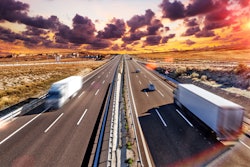
Technology in the realm of food and food procurement has marked some of the watershed advancements in the history of the human race. From the advent of fire, which enabled cooking and led to a previously unseen caloric intake, to the production of agriculture, which provided the conditions to transition from hunter-gatherer tribes to permanent settlements, the progress of food has been the story of human change.
Artificial intelligence (AI) is, and has long been, the next chapter in the story, bringing new possibilities into clear sight within the food logistics industry. Some thinkers are calling it “the next Big Bang,” others are looking forward to operating farms from space. Regardless of those claims, AI has already made a measurable impact on multiple levels. AI-empowered technologies are changing the short-term and long-term outlook in the food logistics industry. Here are three areas of tangible rapid change and the larger implications that could follow.
AI vs. the elements
Since the proliferation of AI technologies have made many smart solutions easier to afford and integrate, some of the more dystopian claims in the industry are being positively disproved. Rather than replacing entire industries and displacing major demographics in the workforce, AI is mostly just abstracting the kinds of labor-intensive data gathering, mining and analyzing that the human brain was arguably never meant to do. Freeing up talented workers for other areas of focus, the data-related capacities of AI technologies are perhaps their most valuable addition to the food logistics space, especially when it comes to the industry’s largest disruptor: the natural world.
Use-inspired AI is offering more insight into the considerations suppliers can’t account for such as crop traits, environmental conditions, soil quality measures and patterns and seasonal consumer shifts. While true foresight might still be impossible, AI-empowered technologies can analyze growth conditions for success patterns and early warning signs, aiding the agricultural production of food, improving the safety and making it more possible for procurement professionals to understand the changes in available supply. With more data, we could have real hopes of understanding yield sensing and forecasting, water and nitrogen stress, improved cleaning of produce and enhanced understanding of both environmental wellbeing and individual health effects. Further application of the data could result in important solutions regarding the way the food system interacts with, depends on and extracts from the conditions of the environment; a change that can’t come fast enough.
AI vs. supply
In similar fashion, there’s no end to the unexpected problems that can crop up along the food logistics supply chain. The global trade restrictions and tariffs were only one example of supply chain hiccups in the pandemic-era. Ongoing challenges include the high cost of labor, time-intensive work and the importance of safety and birds-eye observation at the ground level.
AI has answers to almost all of the above. Deep learning, machine learning and AI can understand and abstract the requirements for robotic processes; dangerous or repetitive tasks can be managed by smart machines. In addition, consumer data from restaurants, grocery stores, online orders and other point-of-sale options can be optimized to alert supply chain professionals to the changes in demand. More foresight between companies and suppliers will result not only in less food waste, but also in the ability to farm with the end product in mind—a shift that could again reduce the ecological footprint of the sector at large.
AI vs. equity
Food insecurity has been an evergreen crisis since the beginning of the human story, and while we’ve made important progress in the right direction, the number of families who went hungry last year alone proves we have a long way to go. And, in working toward that necessary human rights achievement, AI is becoming an indispensable development.
The first area of promise is the capacity for AI to support smaller farming practices. Equipping smaller-scale farmers with the information they need to monitor soil conditions, forecast their supply and streamline their operations would diminish global dependence on unsustainable big-farming practices. If AI-supported technologies could mitigate the need for repetitive manual labor, improve a farmer’s oversight and streamline the management of livestock, the resulting increase in the farm’s production could make smallholder farming far more profitable. Further, those production margins—if properly distributed—could make all the difference in the answer to world hunger.
The environmental reprieve, diminished deforestation and reduced overproduction that would result from smaller-scale farming would improve the ecological state of the industry, which could make an impactful difference in the worldwide delivery of nutrition. Sustainable farming looks like smallholder farmers finding sustainable profits and less environmentally exploitive ways to carry out their processes—AI-empowered technologies lie at the heart of both.
Food creation, procurement, supply and delivery is getting smarter. AI-empowered technology is positioned to change everything, from the way we can contend with the natural world to the way we can support a growing population. The ripple effects might change everything we know about the food logistics industry. And, like all great advancements, that will mark the beginning of a new and improved story.




















